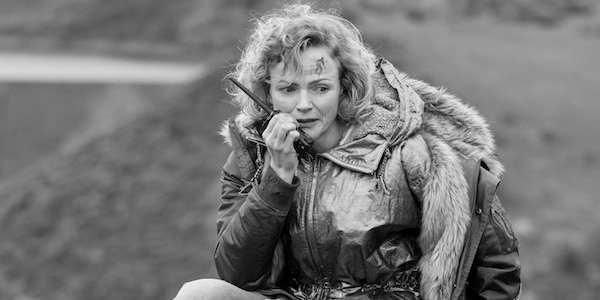Why Black Mirror Went Black And White For That Crazy Season 4 Episode

2017 entered its final days in the only way it should have: with a brand new season of Black Mirror to remind us that life can always be that much more technologically horrifying. The most terror-driven installment in Season 4 was arguably the starkly different "Metalhead," and CinemaBlend was lucky enough to talk to speak with episode director David Slade about those stark differences. Slade was brought into Black Mirror and given free rein with his directing choices, and here's what he said when I asked about the decision to make this Black Mirror's first black-and-white episode.
There was a sense of -- what I always go for is emotion -- a sense of foreboding [in the script]. It was a very uneasy sense of imminent dread as I was reading it, all the way through it. Also, this was also a world where there was some event that had happened, and that it was unspoken and it wasn't anything that we were gonna [explain]; it wasn't even that important. . . . I just said to them, 'Look, this world should look as if it was made out of metal. You know, the whole thing, it's called 'Metalhead.' There's a very stark nature to it all. The locations I think we should be using are all kinda -- not post-apocalyptic, because that would be a little cliché -- but the lands, the marshes, the English countryside: we want to be looking at that. We don't want to be looking at that like a Merchant Ivory film, we want to be looking at it like it's the end of the fucking world.' So it just seemed to make sense thematically, as well as tonally and atmospherically.
For almost all intents and purposes, going black and white seems like the only reasonable move for David Slade to have made when turning Charlie Brooker's "Metalhead" script into live-action dread. The story's stripped-down appeal lent itself particularly well to a similar stripped-down visual approach, since the plot is essentially a no-frills take on "Man vs. Machine." (Or "Woman," as it were.) Slade is responsible for some of the most gorgeous TV episodes in recent years, on shows like American Gods and Hannibal, and he would have likely crafted some equally beautiful footage had he kept natural color schemes intact. But something major would have been lost in the tone and atmosphere departments.
"Metalhead" is basically about a botched supply mission taken by Maxine Peake's Bella and other quickly disposed-of survivors of an unspecified potentially apocalyptic event, with the main protagonist being a robotic "dog" with zero on its digitized mind beyond taking Maxine down. Because it's never quite clear where the dog-bot came from, or what the situation was with Maxine's group, it's up to the viewers to come up with background details for everyone's stories, which muddies things up a bit. And what better way to tell a morally gray story than to film it in the two colors that make up the color gray?
The way David Slade puts it, he apparently didn't have to twist anyone's arm to get the black-and-white process approved. And once it was decided, the production team went all out to make sure no black-and-white stone was left unturned.
It was a very easy conversation. I just said, [mumbling quietly] 'I think we should do this in black and white.' And they agreed, and it was easy. We did some camera tests and made sure that things were practical, and that there weren't any issues to do with black and white. But thematically, everyone was very happy, and so we did everything in black and white. In fact, we did all of our location photos [that way]. We basically said let's start getting used to this, let's do wardrobe photographs, let's do makeup tests, let's do everything in black and white so we just get ourselves immersed in that. And of course when you shoot with native black and white cameras -- we used the red monochrome camera with tests, which was the one we liked -- so there was no choice to go back and do it in color later. Which was important to me as well. It was like, 'I don't want you changing your mind later.'
Considering the past few years of U.S. holiday programming has included colorized versions of I Love Lucy and Dick Van Dyke Show episodes, I suppose that's a fine worry to have. Not that I think anyone would particularly want to give this episode a polychromatic touch-up, but David Slade still made such a thing that much harder to deliver.
While a casual fan might not consider all the difficulties involved with making "Metalhead" a black-and-white installment, David Slade assured me it was quite the complicated process, though not a frustrating one; that almost works as a microcosmic description for Black Mirror in general. The production team was actually strapping GoPro cameras onto their black-and-white cameras so that they could initially figure out the color tracking. Slade also told me they used actual LiDAR cameras in order to bring the robot dog's vision to life. (LiDAR stands for "Light Detection and Ranging," and uses laser lights to measure distances.)
Speaking of that dog-vision, I noted to David Slade that this might be the first time I've ever seen a robot character's standard P.O.V. shown in black and white before. And the director told me there was a brief moment when he and Charlie Brooker considered breaking the fourth wall by showing the dog's LiDAR moments in their original multi-color format.
Your Daily Blend of Entertainment News
It makes sense that it would be in black and white because you're creating a world that exists for 40 minutes or whatever that is, that has to sit within that, it didn't seem to make sense to suddenly [jump to color]. Or rather, I talked about that with Charlie Brooker. We very quickly decided it would be too much of a statement -- you know, because if you see a lot of LiDAR footage, it's all sort of rainbow colors, and it just didn't seem to make sense.
Jumping from black and white to color would have been a jolt for sure, though probably not as big a jolt as viewers got in the heartbreaking final minutes of the episode. "Metalhead" may have been a different Black Mirror installment for many different reasons, but it was par for the course in terms of hauntingly wrapping things up.
Black Mirror Season 4 is currently available to stream in full on Netflix, as are the first three seasons, so be sure to ring in 2018 with some tech-laden pessimism. Check out some of the cameos you may have missed from the Star Trek-esque installment, and when you're wanting to know what else is on the way in the near future, head to our 2018 Netflix schedule and our midseason premiere schedule.

Nick is a Cajun Country native and an Assistant Managing Editor with a focus on TV and features. His humble origin story with CinemaBlend began all the way back in the pre-streaming era, circa 2009, as a freelancing DVD reviewer and TV recapper. Nick leapfrogged over to the small screen to cover more and more television news and interviews, eventually taking over the section for the current era and covering topics like Yellowstone, The Walking Dead and horror. Born in Louisiana and currently living in Texas — Who Dat Nation over America’s Team all day, all night — Nick spent several years in the hospitality industry, and also worked as a 911 operator. If you ever happened to hear his music or read his comics/short stories, you have his sympathy.
